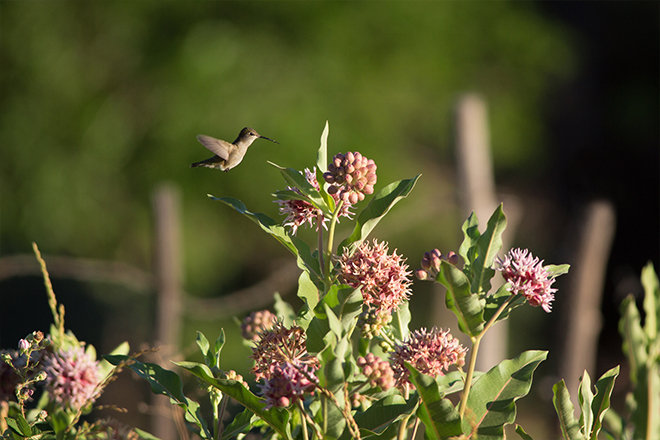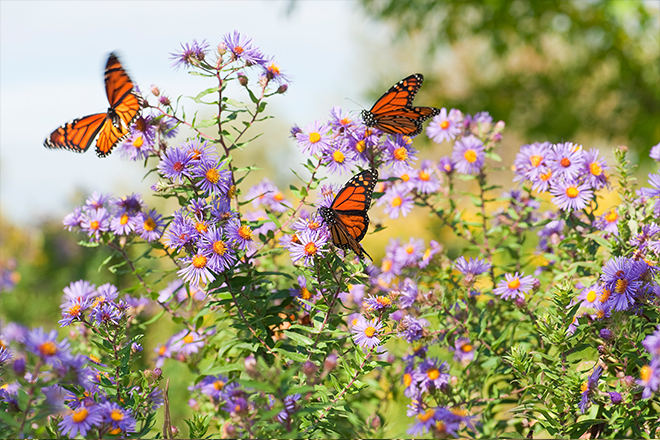Milkweed and wildflowers, flutters and hums … and autumn flushes
Story by Tom Carpenter
Lead Photo by Marissa Jensen
Growing up in the hill-and-dairy country of Southwest Wisconsin, a young teenager took employment where it came, and usually that involved agricultural endeavors. For me, that often meant tossing haybales from baler to wagon and then wagon to loft, or serving as fill-in milkhand when a farmer or his regular hired hand needed an evening off.
But there was one job that I despised and always avoided or outright turned down: Chopping milkweed. Call it my first act of civil disobedience or perhaps moral fortitude, but there was no secret even back then that milkweed served as the host plant for the monarch butterflies I loved, and I didn’t see the fuss.
The job itself was actually easy: Walk around in a cow pasture carrying a spade and chop milkweed plants at the stem so they couldn’t progress to bloom and seed and then spread into the soil bank of adjoining cropfield. Chopping plants in the early corn was a job too, so milkweed leaves wouldn’t shade the crop.
Today, with Pollinator Week upon us again and monarch butterflies fluttering on the brink of endangerment and bees themselves humming perilously close to that same precipice, there are vastly different perspectives on milkweed.
In my own wildflower patch, each pioneering milkweed plant is like a wild and treasured bonus prize, carefully nurtured from seedling and allowed to thrive where it sprouted among the feature plants which are, as best as I can manage, reflective of microscopic slice of what the midwestern prairie once was.
On a landscape scale, that’s a key and critical part of what Pheasants Forever and Quail Forever do: put those wildflowers (forbs) on land both public and private that serves all upland wildlife – of course gamebirds but also whitetails and cottontails and songbirds of every description and hummingbirds and salamanders and toads and oh yes … butterflies and bees.
 As the years have progressed, wildflowers have become more and more a staple in PF/QF seed mixes and habitat projects. And this year, the organization will surpass over a billion total milkweed seeds in the ground, since program inception.
As the years have progressed, wildflowers have become more and more a staple in PF/QF seed mixes and habitat projects. And this year, the organization will surpass over a billion total milkweed seeds in the ground, since program inception.
Pollinator habitat is everything habitat. For pheasants and quail, the stem density makes for perfect nesting habitat, and even better brooding habitat for tiny poults to run around in and hunt the insect protein they need to survive and thrive … all under cover from above.
And in fall and winter, the stiff stems stand up to blowing snow and frigid gales, providing prime cover too when springtime comes and many grasses are flat and there’s not much else to hide a gamebird on the landscape.
We should care about pollinators – for the sake of butterflies and bees themselves, but also for the future of our favorite gamebirds. That’s why Pheasants Forever and Quail Forever partner with other concerned organizations – Corteva, Bayer, U.S. Fish and Wildlife Service, Cabela’s Outdoor Fund and many others – to assure the future of pollinators and pollinator habitat.
 Those are the stories we’ll be telling during Pollinator Week. You can be part of the effort – join today or renew your membership, or donate to the cause. You can also do your part by spreading the message to everyone you know and hunt with.
Those are the stories we’ll be telling during Pollinator Week. You can be part of the effort – join today or renew your membership, or donate to the cause. You can also do your part by spreading the message to everyone you know and hunt with.
And by letting that milkweed go.
Milkweed and wildflowers mean wings over the blooms: flutters and hums from butterflies and bees over the colorful and fragrant flowers of summer … and flushes of pheasants and quail over the dried flowerheads of autumn and winter.
Tom Carpenter is editor at Pheasants Forever.
